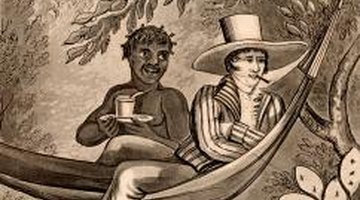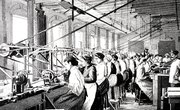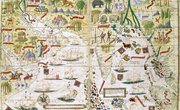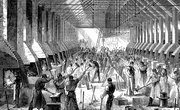Slavery in the 13 British colonies in America grew during the 17th century, largely because the labor force served as an economic engine for colonial prosperity. In 1619, when the first captive African immigrants arrived in America, they worked alongside white indentured servants in the Jamestown tobacco fields. But colonists quickly realized that enslaved Africans were less costly than indentured servants, and the slave trade burgeoned. By 1700, there were 27,817 enslaved Africans living in the colonies, according to the Monticello organization’s website.
Profitable Tobacco Exports
Tobacco was the first crop grown on large farms called plantations, starting in the 1600s. Plantation owners saw an opportunity to get rich by exploiting slaves. Thousands of slaves were acquired to clear land, transplant seedlings, hoe the fields, harvest the crop and pack cured tobacco for shipment. Tobacco production soared in areas with a climate suitable for growing tobacco, such as the Chesapeake region. Cotton was traded to the British for prestigious imported goods, such as art work, silver and ornate furniture. Slave traders also grew wealthy supplying an influx of slaves to affluent tobacco farmers.
Lucrative Rice Production
By 1690, harvesting rice was big business in the South. Colonists had little success growing rice until slaves from rice-growing areas in West Africa taught them cultivation techniques. Growing conditions in South Carolina and Georgia are similar to Sierra Leone, which made slaves from those areas highly desirable and more expensive at auctions. Trusted slaves were appointed as foremen to help manage the large scale operation. Income from rice exported to England helped all the colonies grow and prosper financially.
Societal Acceptance of Slavery
Defenders of slavery in the 1600s professed that the slave industry was morally defensible. Slaveholders suggested they were being virtuous by converting pagan heathens to Christianity. Some Christians also argued that slavery was acceptable because Jesus never spoke out against it and Abraham owned slaves, according to their interpretation of the bible. Permissive societal attitudes condoning slavery helped maintain the status quo and fuel the proliferating slave trade.
Slavery in the Northern Colonies
Although less prevalent than in the South, slavery was also widespread in New England and the Mid-Atlantic colonies during the 17th century. In fact, Massachusetts was the first colony to legalize slavery in 1641. Northern doctors and affluent merchants acquired live-in slaves to help with housekeeping and childcare. The Medford Historical Society says that Northerners turned to slavery as a means of expanding agricultural production and manufacturing activity. Enslaved Africans also worked alongside carpenters, blacksmiths and shoemakers learning a trade and helping the owner do more business.
Related Articles
References
- History.org: Colonial Williamsburg: Introduction to Colonial African American Life
- Monticello.org” Slavery at Jefferson’s Monticello: Paradox of Liberty: Africans in British North America
- Google Books: The Power of Precedent
- Monticello.org: Slavery at Jefferson’s Monticello: Paradox of Liberty: The Chesapeake and the Atlantic World
- Yale University: The Gullah: Rice, Slavery and the Sierra Leone-American Connection: South Carolina Rice Plantations
- Yale University: The Gullah: Origin of the Gullah
- U.S. History.org: The Southern Argument for Slavery
Resources
Writer Bio
Dr. Mary Dowd is a dean of students whose job includes student conduct, leading the behavioral consultation team, crisis response, retention and the working with the veterans resource center. She enjoys helping parents and students solve problems through advising, teaching and writing online articles that appear on many sites. Dr. Dowd also contributes to scholarly books and journal articles.











